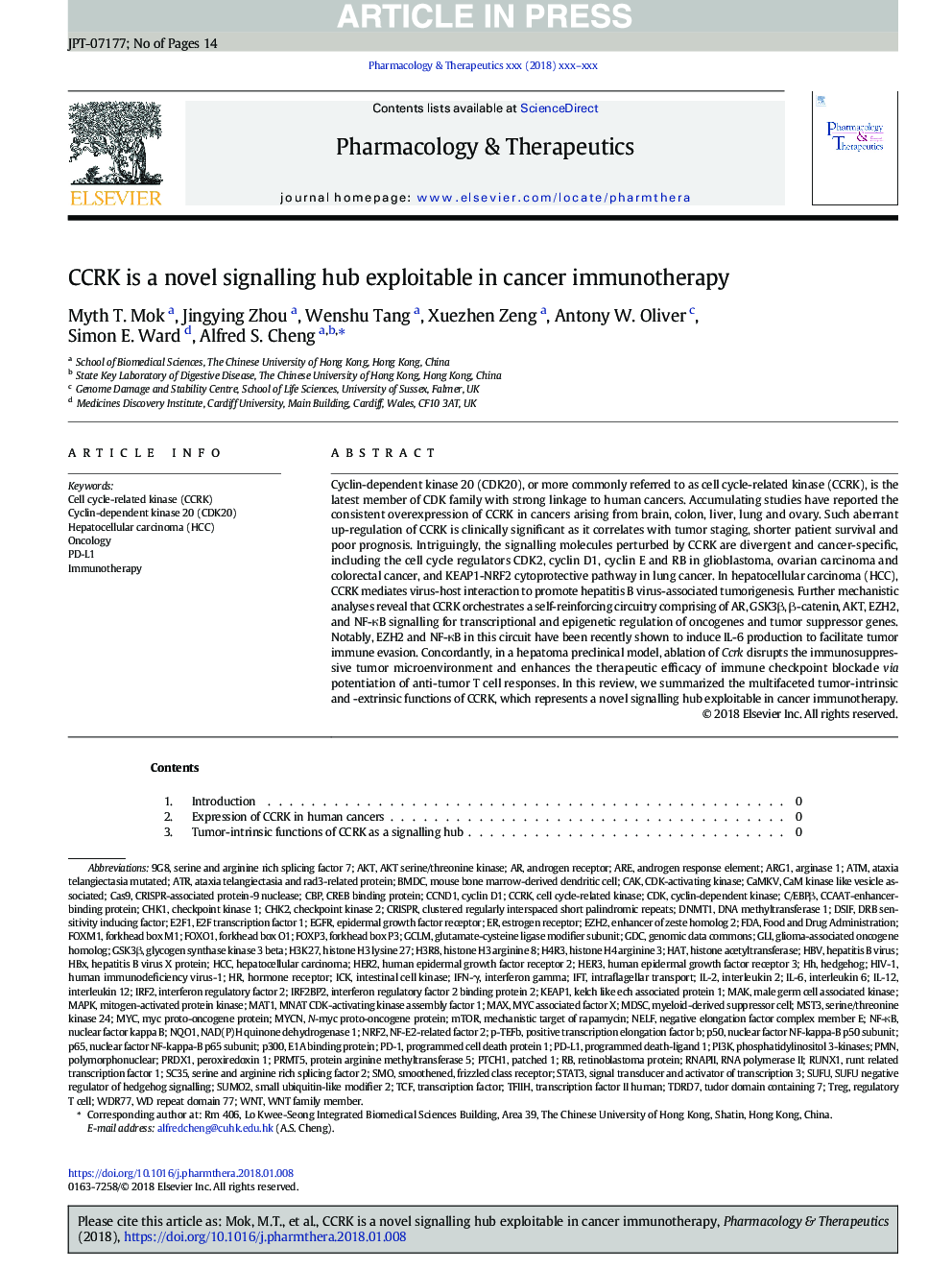| Article ID | Journal | Published Year | Pages | File Type |
|---|---|---|---|---|
| 8536826 | Pharmacology & Therapeutics | 2018 | 14 Pages |
Abstract
Cyclin-dependent kinase 20 (CDK20), or more commonly referred to as cell cycle-related kinase (CCRK), is the latest member of CDK family with strong linkage to human cancers. Accumulating studies have reported the consistent overexpression of CCRK in cancers arising from brain, colon, liver, lung and ovary. Such aberrant up-regulation of CCRK is clinically significant as it correlates with tumor staging, shorter patient survival and poor prognosis. Intriguingly, the signalling molecules perturbed by CCRK are divergent and cancer-specific, including the cell cycle regulators CDK2, cyclin D1, cyclin E and RB in glioblastoma, ovarian carcinoma and colorectal cancer, and KEAP1-NRF2 cytoprotective pathway in lung cancer. In hepatocellular carcinoma (HCC), CCRK mediates virus-host interaction to promote hepatitis B virus-associated tumorigenesis. Further mechanistic analyses reveal that CCRK orchestrates a self-reinforcing circuitry comprising of AR, GSK3β, β-catenin, AKT, EZH2, and NF-κB signalling for transcriptional and epigenetic regulation of oncogenes and tumor suppressor genes. Notably, EZH2 and NF-κB in this circuit have been recently shown to induce IL-6 production to facilitate tumor immune evasion. Concordantly, in a hepatoma preclinical model, ablation of Ccrk disrupts the immunosuppressive tumor microenvironment and enhances the therapeutic efficacy of immune checkpoint blockade via potentiation of anti-tumor T cell responses. In this review, we summarized the multifaceted tumor-intrinsic and -extrinsic functions of CCRK, which represents a novel signalling hub exploitable in cancer immunotherapy.
Keywords
EGFRSTAT3NF-κBPI3KCDKHER2Cas9IL-6CRISPRFOXP3PD-1ATRMYCPD-L1Nrf2mTORHER3FOXO1TCFSufuP300IFN-γIL-2CBPARG1P65GSK3βNELFP50WntTregCyclin D1Dnmt1PMNMAXHBxNQO1FOXM1EZH2P-TEFbSC35IL-12H3K27GliPTCH1SMOMDSCCCND1Chk1E2F1BMDCIRF2GCLMRunx1DSIFDNA methyltransferase 1MAT1IFTTFIIHCHK2Phosphatidylinositol 3-Kinaseshuman epidermal growth factor receptor 3GDCICKPRMT5ataxia telangiectasia and Rad3-related proteinCAKSUMO2RNAPIIFDAhistone H3 lysine 27Kelch like ECH associated protein 1Prdx1AKT serine/threonine kinaseMyc associated factor Xglioma-associated oncogene homologMST3DRB sensitivity inducing factorRNA polymerase IIataxia telangiectasia mutatedkeap1c/ebpβCDK-activating kinaseHCCmAKMAPKNAD(P)H quinone dehydrogenase 1MYCNarginase 1AktOncologyimmunotherapyinterleukin 12interleukin 2interleukin 6checkpoint kinase 1checkpoint kinase 2clustered regularly interspaced short palindromic repeatsenhancer of zeste homolog 2Forkhead box O1forkhead box M1forkhead box P3Hedgehogintraflagellar transportATMFood and Drug AdministrationRegulatory T cellmyeloid-derived suppressor cellNF-E2-related factor 2interferon regulatory factor 2Transcription factorE2F transcription factor 1androgen response elementnuclear factor kappa Bsignal transducer and activator of transcription 3Positive transcription elongation factor bprogrammed death-ligand 1Mechanistic target of rapamycinAREhepatitis B virus X proteinHBVHistone acetyltransferaseHIV-1human immunodeficiency virus-1hepatitis B virusPeroxiredoxin 1Protein arginine methyltransferase 5CREB binding proteinCcaat-enhancer-binding proteinretinoblastoma proteinprogrammed cell death protein 1mitogen-activated protein kinasePolymorphonuclearPatched 1Hepatocellular carcinoma (HCC)Hepatocellular carcinomaHATglutamate-cysteine ligase modifier subunitcyclin-dependent kinaseInterferon gammaglycogen synthase kinase 3 betaAndrogen ReceptorEstrogen receptorHuman epidermal growth factor receptor 2Epidermal growth factor receptorhormone receptor
Related Topics
Health Sciences
Pharmacology, Toxicology and Pharmaceutical Science
Pharmacology
Authors
Myth T. Mok, Jingying Zhou, Wenshu Tang, Xuezhen Zeng, Antony W. Oliver, Simon E. Ward, Alfred S. Cheng,
